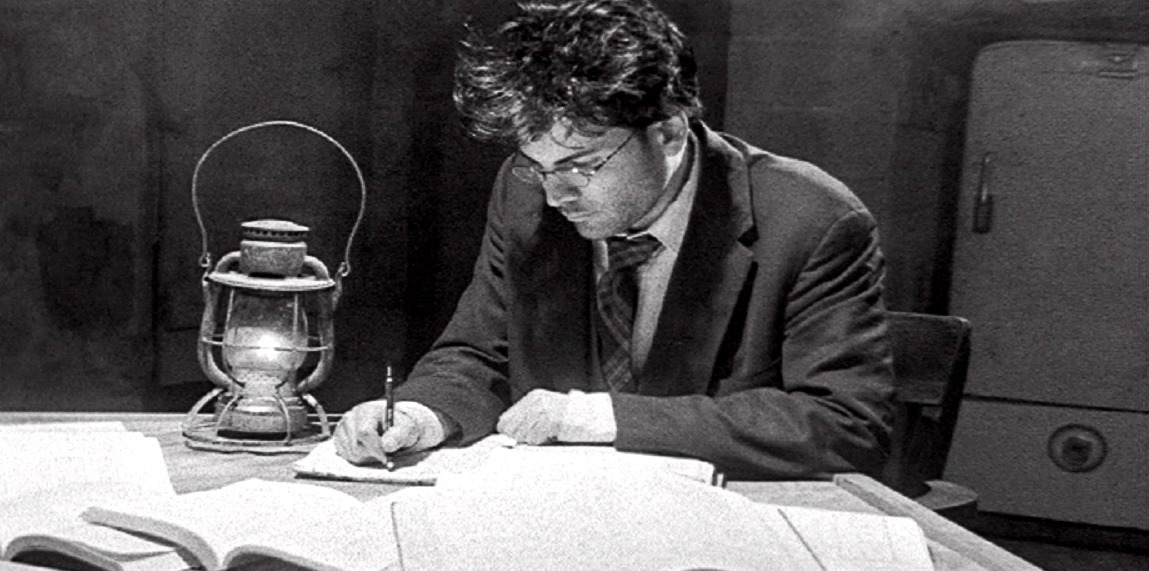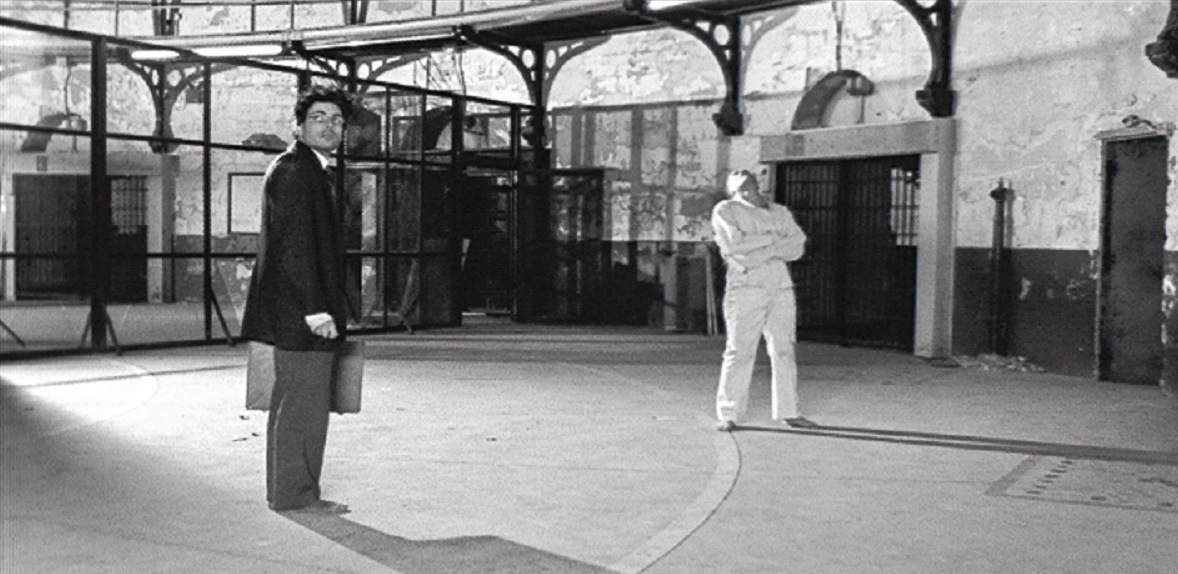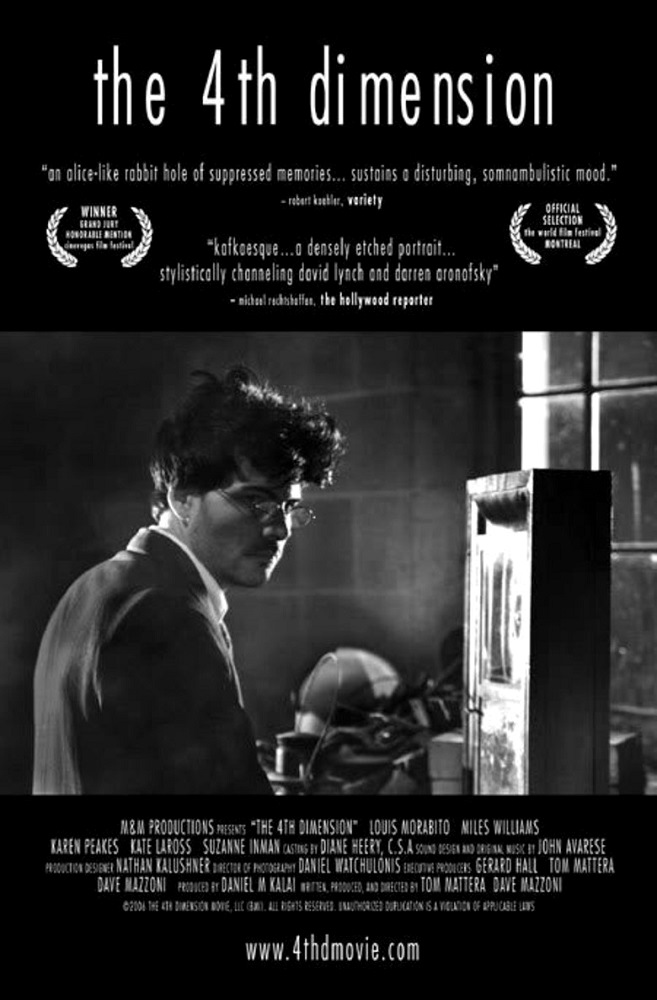Crew
Directors/Screenplay – Tom Mattera & Dave Mazzoni, Producers – Daniel M. Kalai, Dave Mazzoni & Tom Mattera, Photography (b&w + some scenes colour) – Daniel Watchulonis, Music – John Avarese, Production Design – Nathaniel Kalushner. Production Company – M&M Productions/The 4th Dimension Movie, LLC.
Cast
Louis Morabito (Jack Emitni), Miles Williams (Young Jack), Karen Peakes (Amanda Emitni), Kate LaRoss (Michelle Williams), Louis Lippa (Otto), Suzanne Inman (Emma), Ruth Leon Weiman (Mrs Reiker), Abe Goodhart (Charles)
Plot
Jack Emitni works as an antique restorer in Philadelphia. He suffers from Obsessive Compulsive Disorder and repeats banal actions over and over. Jack is also obsessed with time and has dreams of his mother who died when he was a boy. A mystery woman knocks at the door of Jack’s apartment and gives him a clock. In trying to repair the clock, Jack has dreams about Albert Einstein and begins to dwell on Einstein’s equations concerning time. He postulates that time is not regular and that there exists alternate realities between moments. His troubling dreams draw him back towards an old abandoned psychiatric hospital.
The 4th Dimension is an independently made debut feature from Tom Mattera and Dave Mazzoni, two ingenue Philadelphia-based directors fresh from film school. Mattera and Mazzoni began making The 4th Dimension as a short film and raised a $75,000 budget to expand it as a feature film. The 4th Dimension received favourable notice at several film festivals.
I have always been a sucker for the type of film that reaches for cosmic mystery and the Meaning of It All – 2001: A Space Odyssey (1968), Solaris (1972), Altered States (1980) and Pi (1998) to name but a handful. In its promotional description, The 4th Dimension comes with a conceptually exciting stew of ideas – mysterious clocks that give insight into the true nature of time, mention of Albert Einstein’s never-solved Unified Field Theory – which have the solid promise of a good conceptual Meaning of It All film.
The two conceptual godparents of The 4th Dimension are Pi – any film that comes shot in black-and-white and is obsessed with the Meaning of It All through mathematics, not to mention takes us inside the fractured headspace of an obsessed man, cannot help but source Pi – and David Lynch’s Eraserhead (1977), which was also in black-and-white and created a similar obsessively surreal sense of dis-ease.

Mattera and Mazzoni do a fine job in evoking the innerspace inhabited by the protagonist. Although, rather than plunging us into the visual equivalent of a migraine headache as Pi did, The 4th Dimension has a tone that is more like a bleak wintry poem. Mattera and Mazzoni shoot numerous desolate scenes of frozen snowy landscapes, bared trees and abandoned railway stations. The film is edited in sometimes blankly disjunct shots. Events becomes increasingly more surreal – a mysterious femme fatale appears at Louis Morabito’s door with the clock; his apartment is overrun by toy trains that come to seem like organic objects that start growing and taking over.
One of the finest parts of the film is the soundtrack from John Avarese. Avarese creates a densely brooding soundscape that seems perpetually alive with thrumming industrial noise just on the threshold of aural perception, which does a substantial part of creating the film’s sense of inhabiting an oppressive psychological space.
The main complaint might be that, while The 4th Dimension does a fine job of existing as a state of mind, it never coheres into a narrative. The entire film is a non-linear series of individual scenes that are placed seemingly at random but without the sense of ever going anywhere dramatically as a story.
The filmmakers have certainly done their homework and there are some mesmerising voiceover speculations on dimensionality, time and parallel worlds theory. There is a particularly good scene where the teacher in classroom is trying to get the kids to draw a straight line and suddenly young Jack (Miles Williams) starts giving a lecture on Einsteinian Space-Time and how this renders the question of a straight line meaningless. It is a wonderful moment that opens the film out from something ordinary into the genuinely reality-bending conceptual arena of Relativity and Space-Time. It is rare to find a film willing to grapple with such heady conceptual matter as this. Amid these dreamy shiftings between present and past, the ideas raised about the existence of parallel worlds and the hero wondering if it is possible to move between the irregularities in time, one sits in anticipation wondering what kind of unique cosmological places that Mattera and Mazzoni are taking us.

This unfortunately is an anticipation that is left unrequited. [PLOT SPOILERS]. In a twist ending, Mattera and Mazzoni reveal The 4th Dimension to be an M. Night Shyamalan-esque film of sorts – one that is built around a big conceptual mystery and an eventual twist revelation that turns everything on its head a la The Sixth Sense (1999) and The Village (2004). The twist they eventually unveil is that all that has happened has been taking place inside the subjective headspace of a mentally ill man. The last few minutes burst from black-and-white into colour as the film takes us into to the grounds of Philadelphia’s real-life disused Byberry psychiatric institution. Here we learn that Jack was one of the ex-patients that were left homeless once the institution was shut down and, with nowhere to go, kept obsessively returning to the ruins of what they knew.
Mattera and Mazzoni seem to have a genuine concern for Byberry, which, according to the extensive title cards on the end credits, was an institutional hellhole that was badly overcrowded and rife with official abuse and neglect before being shut down in 1990. (We even get to see a number of still shots of various former inmates as the end credits roll). Byberry’s reputation grew into urban legend, with stories of it being haunted and Satanic rituals being conducted in the abandoned tunnels. Mattera and Mazzoni were one of the few filmmakers that were granted permission to film on the grounds before Byberry was bulldozed in 2006.
While an intriguing and thoughtful surprise, this twist ending does end up being somewhat of a cheat on the film that one thought they were seeing at the outset. The intriguing aspects about the mysterious clock, Einstein’s unsolved formula and the talk of time and parallel worlds that the film sets up all eventually end up being a red herring that is ultimately of no relevance to the film we end up seeing. (All the obsession with time and parallel worlds is revealed to be a longing by Jack to reconnect with his late mother). Indeed, the type of film that one thought that The 4th Dimension would be before sitting down to watch it – a Pi-like reality bender about mathematics and the Meaning of It All – is completely different to the type of film that we have ended up seeing by the time the end credits roll – a subjective depiction of the inner state of a mentally ill man’s mind along the lines of Repulsion (1965), Pink Floyd – The Wall (1982) or Spider (2002).
Tom Mattera and Dave Mazzoni next went onto make the true crime horror film The Fields (2011).


